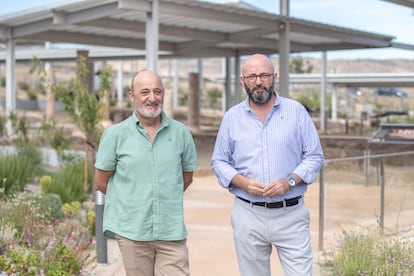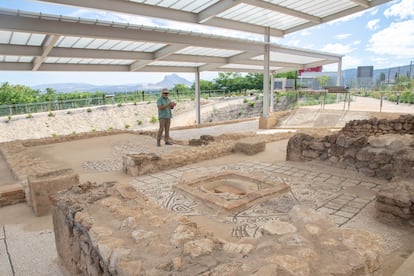Licinia Logas was one of the most powerful women in Roman Antikaria. He died at age 35 and was buried very close to the spectacular villa owned by his family, the Licinios. Like her, during generations they dedicated themselves to the production of olive oil in the lands of Roman Bética, turned into something similar to the current DCOOP business giant, also from Antequera, but in family version. They showed their power in a house that was pure luxury to impress visits and that, 16 centuries later, it is still surprised by becoming an archaeological site. Only a quarter of its 23,000 square meters of singular terraced architecture has been excavated, but the largest geometric mosaic of the Iberian Peninsula has already been found, one of the scarce hippo sculptures of the Roman Empire, dozens of golden tessels and marbles arrived from half the planet. All this can be seen, after more than two decades of excavations, in the baptized as Roman Villa de la Estación, north of the Malaga town of Antequera (41,619 inhabitants), which opened the public on July 17.
The Licinios began to raise their Antequerano home back in the year 250. Several generations resided, which were improving the building until shortly after 500, when they abandoned it. In those two and a half centuries formed an exclusive villa. Today it can be seen thanks to a set of coincidences that allowed their conservation underground, but also to the tireless work that Manuel Romero, municipal archaeologist of Antequera, together with a good number of researchers.
Before them, archaeologists Martín Ansón and Amador de los Ríos gave the first news of the town when they found coins, marbles and tessels at the end of the 19th century while planting some trees. Later, archaeologist Antonio García Bellido continued the investigation that allowed the plot to be under protection against future urban development. It was key that, when a road was projected just above, archaeological tastings were practiced in 1998. They brought multiple surprises and forced to change the road layout. Declared of cultural interest since 2006, after many years of bureaucratic problems, lack of financing and political interest, today it has become the most relevant Roman archaeological site in the city.
The property was built in the antikaria suburbs, the current Antequera, next to a Via Domitiana that was heading towards the current Malaga and Córdoba. It was the most expensive point, since it was close to the forum – about 15 minutes on foot – and far from the noise of the public city. They also separated it from the inconveniences of the agricultural facilities where the oil was made and had won, located about 300 meters below. The good connections with the Empire and the wealth that the family accumulated are seen with the naked eye despite the fact that only 23% of the villa – given on multiple terraces – has been excavated and the rest continues under the asphalt of a street, a building and a hill that rises to the hostel.
That quarter is enough, however, to understand their greatness and the impression they had to cause in the people they were dealing with. “Everything served to show that they had contacts, that they were cults, that they knew of mythology and were powerful: the perfect place to do business,” says Romero, which recalls the importance of oil in Rome not only as food, but also for combustion, medicines, perfumes, fertilizer or massages. In the surroundings there are another 39 Roman villas dedicated to this product, but never separated from the oil mill or with so many ostentatious details.
There is nothing more to look at the main mosaic, part of a gallery overlooking Vega and the Peña de los Enamorados, which with its 302 square meters is already the largest with geometric motifs of the Iberian Peninsula. Their numbers scare: according to the investigators’ calculations, it accumulates almost 2.5 million tessels, one by one by a huge team of the best artisans, as reflected in the quality of the figures. “It is something that denotes the economic capacity of the owners,” says Sebastián Vargas, professor at the Department of Prehistory and Archeology at the University of Seville. It is just an example of the 11 that are in sight – one of them in Cuesta, another uniqueness – among those who occupied the floor of all the rooms and corridors of the town as a carpet. “They are very well made and there are no prominence to the paintings, sculptures and the architecture of the building itself; in return, they provide decoration, reference and elegance,” says Vargas.
Solomon’s knots – typical decorative motive, in which two links are intertwined – and the lotus flower are the most common representations, although there are also some plant reasons. The main colors are white, black and ocher, but some of the vitreous pasta rocks with which pieces of many other colors have been found among the remains of a workshop located in the town. It is unknown if they were used on the walls or are yet hidden under the earth. The materials are exposed in the City Museum of the city, where you can also see 33 golden golds coated with gold -protected gold bread, found on the site. Also, part of an import marble composition that represent a calamón (a kind of bird) “of tremendous quality”, according to Vargas. These marbles decorated the walls as a plinth.
Hippo sculpture
The other more striking element is peristyle, the patio surrounded by columns – white marble on a red background, from El Torcal – two heights, which has a pond of 180,000 liters, which does not have parallels in the Roman Hispania. Inside there are four alcorques that, by way of islands with vegetation, had different sculptures that exerted as a supplier, including those of a hippo, another exception. “This is one of the best sculptural repertoires of Roman Bética,” says Romero. 12 pieces have been found in good condition, where a Venus of the second century and a bust of Nero stand out. This is status symbol: while other families narrated their history or made references to mythology in the mosaics, the most powerful, like this, they did it with sculptures.

The water, from a spring still alive, flowed below the house to refresh the rooms of the north – the ones that can be seen today, which were used in summer – as a natural air conditioning. The liquid then filled the pond and, likewise, was reused for the irrigation of the gardens. There, beyond the wide walls of the town – of lime mortar and almost two meters wide – a fountain were located and the hot springs, with three rooms with hot, temperate and cold water pools, as well as the sauna. In addition to marbles from Egypt, North Africa, Carrara (Italy) and France or different points of the Peninsula, during excavation works there were also coins, bronzes, 1,300 oyster shells and a sculpture of ancient Greece.
After investing a million euros – the fourth part suffered by the Antequerano City Council and the rest by the 2% cultural program, whereby the State provides that percentage of each public works – pergolas protect the reservoir of winter frosts and give shade in summer to avoid intense Andalusian heat, although most visits in the summer season have been planned in night.
“The future goes on to investigate more and invite university professionals to continue working,” explains José Medina Galeote, Councilor for Culture, who does not rule out that excavation can be expanded to find new secrets of the town. “This is the less intimate part of the house. How will the rest be, the most stately,” he warns with illusion while archaeologists rub their hands with what they can find hidden under tons of earth.

